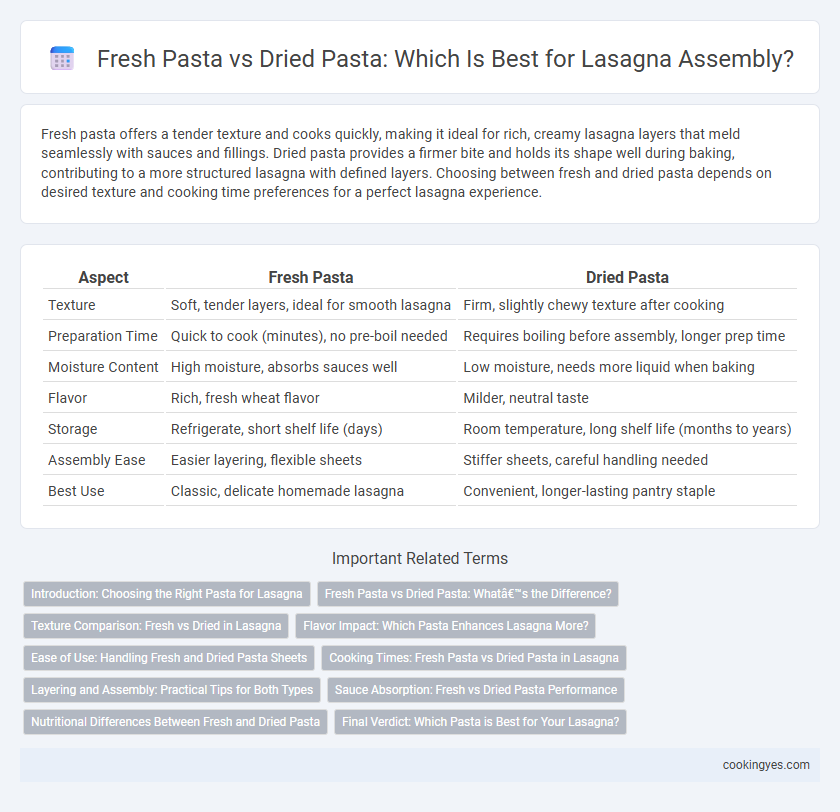Fresh pasta offers a tender texture and cooks quickly, making it ideal for rich, creamy lasagna layers that meld seamlessly with sauces and fillings. Dried pasta provides a firmer bite and holds its shape well during baking, contributing to a more structured lasagna with defined layers. Choosing between fresh and dried pasta depends on desired texture and cooking time preferences for a perfect lasagna experience.
Table of Comparison
| Aspect | Fresh Pasta | Dried Pasta |
|---|---|---|
| Texture | Soft, tender layers, ideal for smooth lasagna | Firm, slightly chewy texture after cooking |
| Preparation Time | Quick to cook (minutes), no pre-boil needed | Requires boiling before assembly, longer prep time |
| Moisture Content | High moisture, absorbs sauces well | Low moisture, needs more liquid when baking |
| Flavor | Rich, fresh wheat flavor | Milder, neutral taste |
| Storage | Refrigerate, short shelf life (days) | Room temperature, long shelf life (months to years) |
| Assembly Ease | Easier layering, flexible sheets | Stiffer sheets, careful handling needed |
| Best Use | Classic, delicate homemade lasagna | Convenient, longer-lasting pantry staple |
Introduction: Choosing the Right Pasta for Lasagna
Fresh pasta offers a tender texture and delicate flavor that enhances homemade lasagna, allowing for quicker cooking and better absorption of sauces. Dried pasta provides a firmer bite and longer shelf life, making it ideal for batch preparation and extended storage. Selecting between fresh and dried pasta depends on desired texture, cooking time, and recipe convenience.
Fresh Pasta vs Dried Pasta: What’s the Difference?
Fresh pasta for lasagna offers a tender texture and cooks quickly due to its higher moisture content, absorbing sauces more effectively for a rich, cohesive dish. Dried pasta is more shelf-stable and has a firmer bite after baking but requires longer cooking and can result in a chewier texture. Choosing fresh versus dried pasta affects the final lasagna's mouthfeel, cooking time, and sauce infusion, making fresh pasta ideal for creamy layers and dried pasta suitable for a firmer structure.
Texture Comparison: Fresh vs Dried in Lasagna
Fresh pasta sheets for lasagna offer a tender, delicate texture that absorbs sauces more effectively, resulting in a creamier, melt-in-your-mouth bite. In contrast, dried pasta provides a firmer, chewier texture that holds its shape well during baking, adding a satisfying bite and structure to each layer. Texture preferences often depend on cooking time and sauce consistency, with fresh pasta suiting richer, lighter sauces while dried pasta complements hearty, robust flavors.
Flavor Impact: Which Pasta Enhances Lasagna More?
Fresh pasta offers a richer flavor and tender texture that absorbs sauces deeply, enhancing the overall taste of lasagna with a silky mouthfeel. Dried pasta provides a firmer bite and a more concentrated wheat flavor, which can create a hearty contrast to creamy fillings and robust tomato sauces. Choosing between fresh and dried pasta ultimately depends on regional preferences and desired flavor profiles for lasagna dishes.
Ease of Use: Handling Fresh and Dried Pasta Sheets
Fresh pasta sheets for lasagna offer greater pliability, making them easier to layer without cracking or breaking during assembly. Dried pasta sheets require pre-cooking or soaking to achieve the necessary flexibility, which can extend preparation time and complicate handling. Choosing fresh pasta can streamline the lasagna-making process by reducing the risk of tearing and ensuring a smoother assembly experience.
Cooking Times: Fresh Pasta vs Dried Pasta in Lasagna
Fresh pasta cooks significantly faster than dried pasta in lasagna assembly, typically taking just 2 to 3 minutes to become tender during baking. Dried pasta requires a longer cooking time, usually around 40 to 50 minutes, as it needs to fully hydrate and soften in the sauce. Choosing fresh pasta reduces overall baking time and yields a softer texture, while dried pasta offers a firmer bite and longer shelf life.
Layering and Assembly: Practical Tips for Both Types
Fresh pasta sheets are pliable and ideal for layering in lasagna, allowing easy folding and even coverage without breaking. Dried pasta requires pre-cooking or soaking to achieve the right texture, ensuring it softens enough to absorb sauce and meld with other layers during baking. For optimal assembly, fresh pasta reduces layering time and enhances moisture retention, while dried pasta offers a firmer structure that holds up well in multi-layered lasagna dishes.
Sauce Absorption: Fresh vs Dried Pasta Performance
Fresh pasta sheets for lasagna absorb sauce more readily due to their higher moisture content and delicate texture, resulting in a creamier, more cohesive dish. Dried pasta requires longer cooking and sauce exposure to soften, which can lead to a firmer bite and less integrated sauce absorption. Optimal sauce viscosity and layering enhance flavor melding regardless of pasta type, but fresh pasta generally provides superior sauce infusion and moisture balance in lasagna assembly.
Nutritional Differences Between Fresh and Dried Pasta
Fresh pasta for lasagna contains higher moisture content and often provides slightly more protein and vitamins like B-complex due to its minimal processing, while dried pasta offers longer shelf life and a more concentrated carbohydrate content. The glycemic index of dried pasta is typically lower, making it a better option for blood sugar control. Both types deliver similar calorie counts, but the choice affects texture and nutrient retention in the final dish.
Final Verdict: Which Pasta is Best for Your Lasagna?
Fresh pasta offers a delicate texture and cooks faster, delivering a tender bite that absorbs sauce well, making it ideal for rich, creamy lasagna. Dried pasta provides a firmer structure and longer shelf life, resisting overcooking and maintaining distinct layers in hearty, oven-baked versions. Choosing between fresh and dried pasta depends on desired texture and cooking time, with fresh suited for silky, soft lasagnas and dried preferred for robust, structured dishes.
Fresh pasta vs Dried pasta for Lasagna assembly Infographic

 cookingyes.com
cookingyes.com